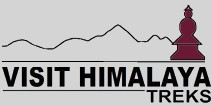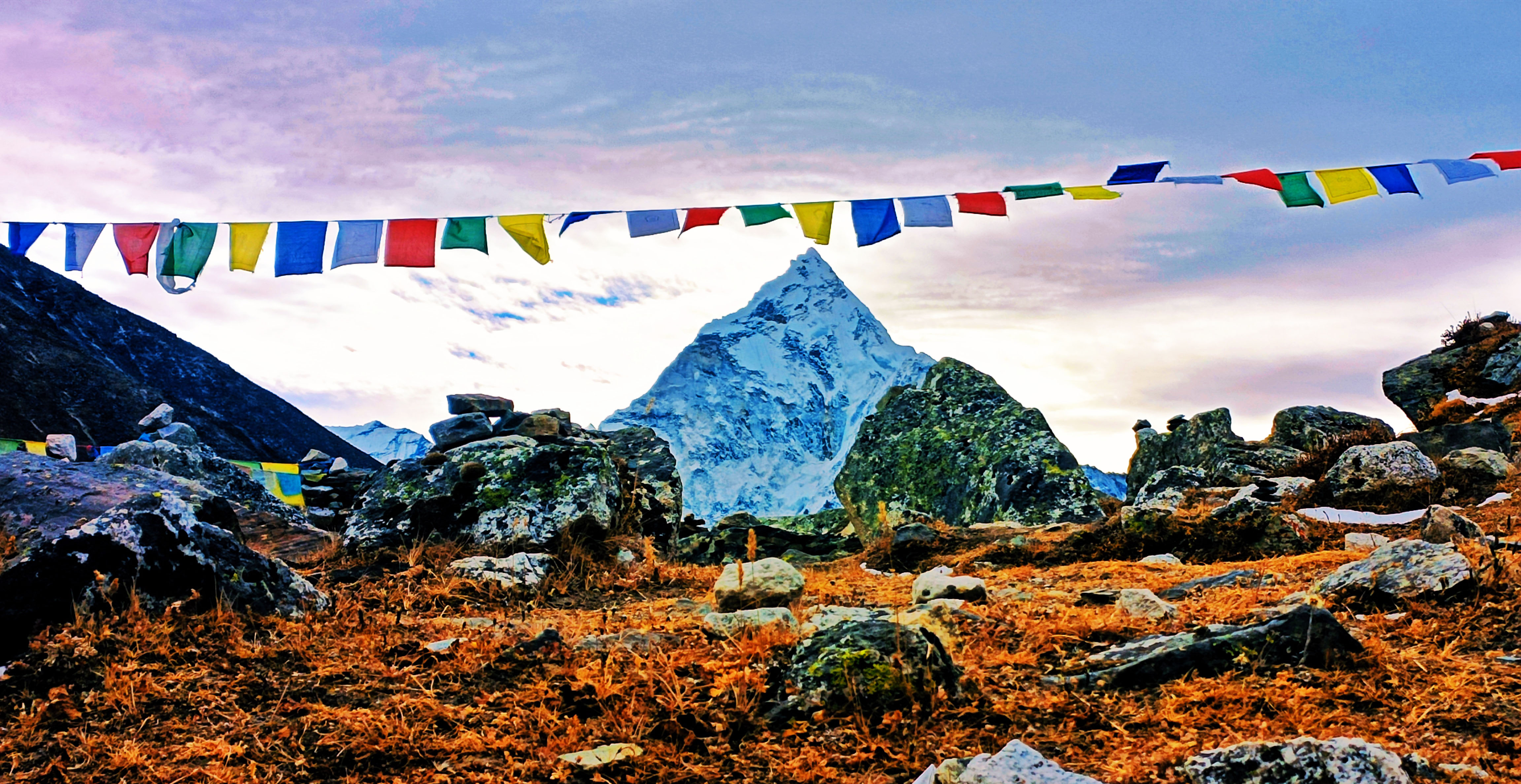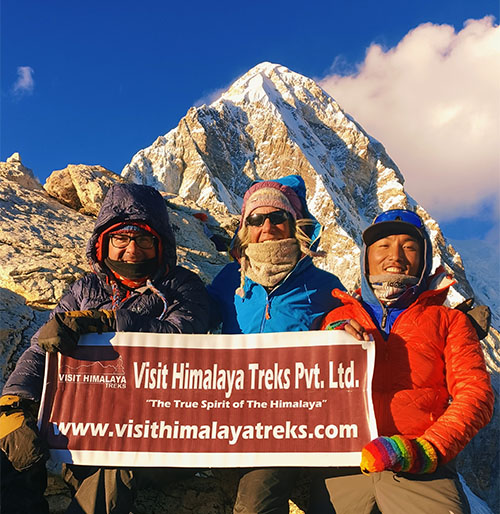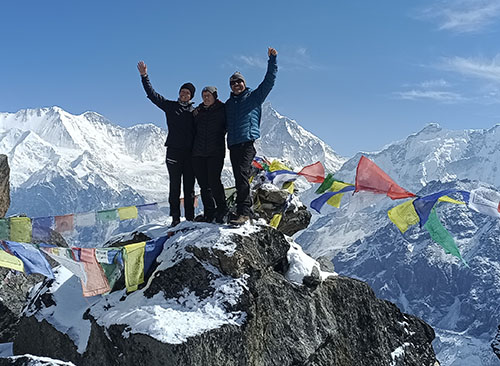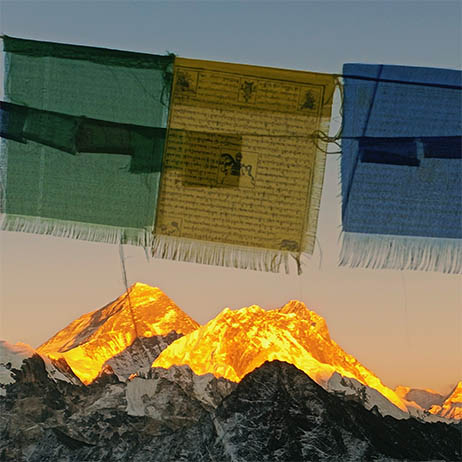The Everest Three High Pass Trek Package is the ultimate experience for hikers who want to venture beyond the conventional Everest Base Camp route and immerse themselves in all that the Khumbu region has to offer. Wise and experienced and dedicated trekkers will love this challenging journey that takes you across the region's three highest and most spectacular passes, namely Kongma La (5535m), Cho La (5330m), and Renjo La (5360m), each with stunning panorama of the world's tallest mountains, including Everest (8848m), Lhotse (8516m), Makalu (8463m), and Cho Oyu (8201m).
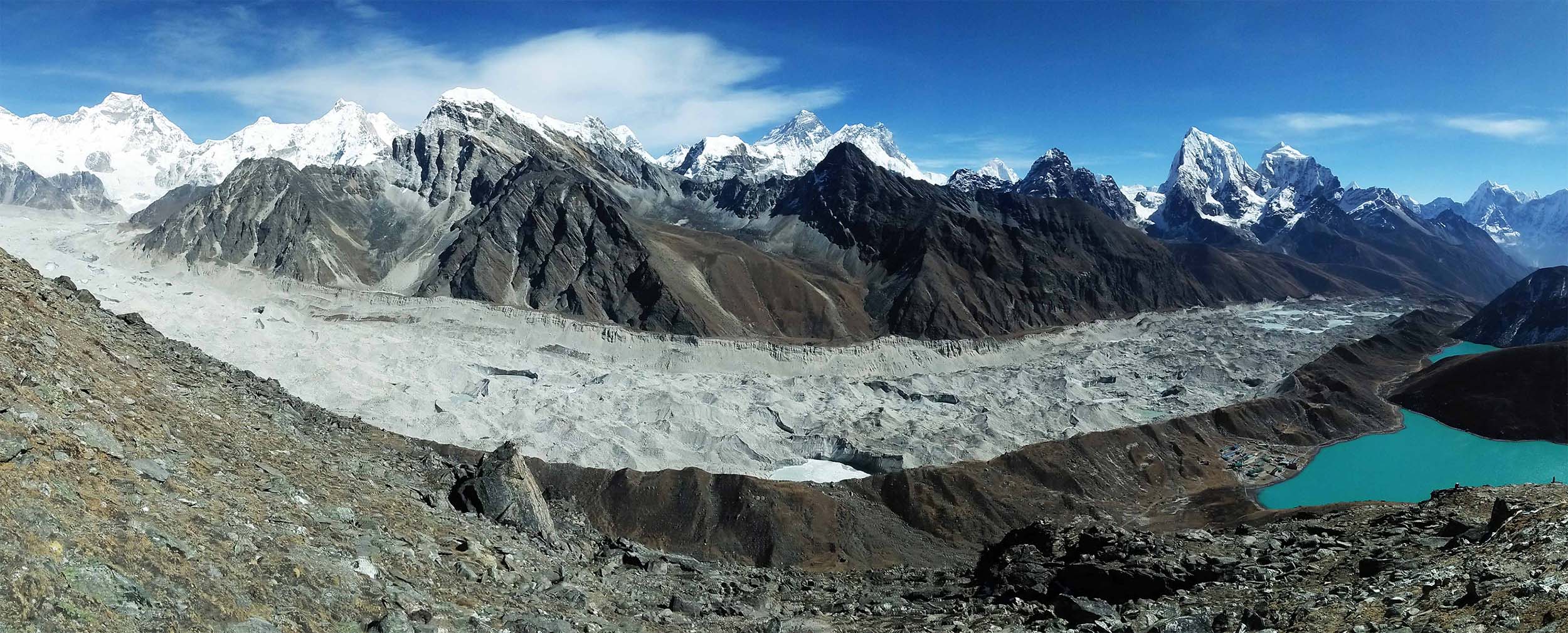
A panoramic view from Gokyo Ri showing Everest and the turquoise Gokyo lakes.
During the Everest Three Pass Trek, you’ll not only reach Everest Base Camp and the legendary viewpoint of Kala Patthar, but also explore hidden gems like the Gokyo Lakes, the Ngozumpa Glacier, the longest glacier in Nepal, and charming Sherpa settlements such as Namche Bazaar, Tengboche, and Thame. This package offers the perfect balance of raw adventure, cultural immersion, and awe-inspiring natural beauty. You will walk over tough terrain, climb high mountain passes, follow unique landscapes, and stop to visit ancient monasteries, all the while immersing yourself in the warm hospitality and Sherpa traditions.
Structured with acclimatization days and a carefully planned itinerary, the Everest Three High Pass Trek Package allows you to maximize the experience while catering to the challenges of high-altitude trekking. Along with being your best bet for a once-in-a-lifetime journey that challenges your limits and lavishes you with great Himalayan memories, this trek is ready when you are.
Quick Facts – Everest Three High Pass Trek Package
- Duration: 22 Days – Complete trek covering three high passes and Everest Base Camp.
- Max Elevation: 5,545m (Kala Patthar)
- Highest Pass: Kongma La (5,535m)
- Trip Grade: Strenuous – Recommended for experienced trekkers.
- Best Season: Spring (Mar–May) & Autumn (Sep–Nov).
- Accommodation: Teahouse / Lodge.
- Transportation: Kathmandu/Ramechhap-Lukla Flight + Trekking
- Start / End Point: Kathmandu.
Highlights of the Everest Three High Pass Trek Package
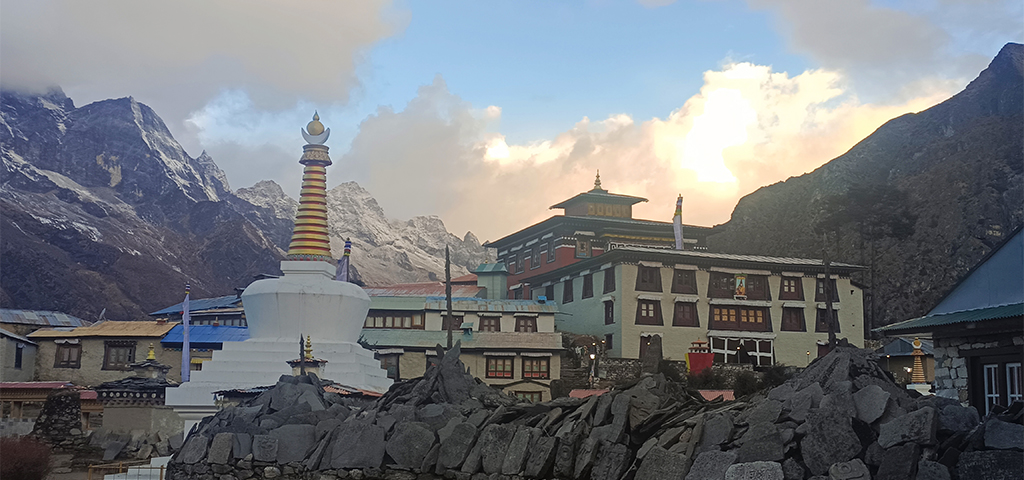
The religiously significant Tengboche Monastery is located on the Everest Three Pass trek route.
- Cross all three of the iconic high passes in Khumbu, Kongma La (5535m), Cho La (5330m), and Renjo La (5360m), each offering stunning, panoramic views of the Everest Himalayas.
- Reach Everest Base Camp (5364m) and stand at the foot of the highest mountain in the world.
- Climb Kala Patthar (5545m) for the most famous up-close sunrise view of Everest and the surrounding mountains.
- See the serene Gokyo Lakes, a chain of blue glacial lakes beneath snow-giant overhangs.
- Hike the Ngozumpa Glacier, the longest glacier in the Himalayas.
- Immerse yourself in [INTERNAL LINK: Link to a blog post about Sherpa Culture] Sherpa culture, visiting such traditional towns as Namche Bazaar, Tengboche, Dingboche, Thame, and Chukung.
- Visit the Tengboche Monastery, one of the largest spiritual centers of the Khumbu.
- Sample diverse landscapes, from lush forests and alpine meadows to high-altitude glaciers and hard-rock passes.
- Well-planned acclimatization days so that one can have a safe and wonderful high-altitude experience.
Everest Three Passes Trek Difficulty
Everest Three Passes Trek is considered to be one of the most challenging trekking routes in Nepal. It demands peak physical fitness, strength, and past experience of high-altitude trekking. Steep ascents and descents, rough terrain, and three high altitude mountain passes above 5,300 meters, namely Kongma La, Cho La, and Renjo La, are faced by the trekkers. Altitude sickness is of serious concern due to the rapid rise in altitude, and hence, cautious acclimatization days are included in the itinerary. The terrain varies from rocky paths and ice patches to tight ridges where sure-footedness and mental strength are required. Even though no technical climbing is done, the trek is demanding and is for seasoned trekkers who can withstand long trekking days in tough weather conditions.
Best Season to Trek the Everest Three Passes
Spring (March to May) and autumn (September to November) are the best seasons to undertake the Everest Three Passes Trek. These periods are characterized by relatively settled weather with clear skies, moderate temperatures, and little precipitation, with wonderful mountain views and perfect trekking conditions. Spring offers blooming rhododendron and colorful scenery, and autumn offers crisp air and post-monsoon visibility. Winter months are snowy and cold; hence, the high passes are less secure and hard to reach. Summer monsoon heavy rain, landslides, and poor visibility make it generally avoided for this trek. Trekking during the recommended seasons will make your trip safe, comfortable, and a memory of a lifetime in the Himalayas.
Everest Three Passes Trek Package Cost
Cost Includes
- Arrival and departure transport by car: We will pick you up from Kathmandu International Airport and transfer you to your hotel.
- A full-day sightseeing tour in Kathmandu with a city guide, including all necessary transportation.
- Three nights’ accommodation in Kathmandu at a 3-star standard hotel with breakfast included (based on double occupancy).
- Round-trip airfare between Kathmandu and Lukla, including all airport taxes.
- Accommodation and all meals (breakfast, lunch, and dinner) during the trek in standard teahouses.
- Salaries, insurance, food, and accommodation for guides and porters.
- A porter to carry your luggage on the trek (up to 15 kilograms per person).
- National Park entry fees and Trekkers’ Information Management System (TIMS) card.
- A first aid kit for emergencies.
- All service charges and government taxes.
Cost Excludes
- Nepal entry visa fees.
- Personal travel insurance, which is compulsory for the trek.
- Lunch and dinner in Kathmandu.
- Entry fees at sightseeing sites.
- Personal expenses such as beverages (mineral water, alcohol, soft drinks), phone bills, laundry, bar bills, personal tips, and other miscellaneous costs.
Essential Information for the Trek
Everest Three Passes Trek Permits
You need several permits issued by the Government of Nepal to trek the Everest Three Passes. They include the Sagarmatha National Park Permit, as the trek passes through the preserved park region, and the Khumbu Pasang Lhamu Rural Municipality Permit (KPLRMP) to guarantee safety and surveillance of the trekkers. Sagarmatha National Park Permit costs around USD 30 for foreign travelers, and the KPLRMP costs around USD 30 for individual trekkers. These permits help regulate tourism, conserve the delicate ecosystem, and ensure safety for trekkers. These permits must be obtained before trekking, and your trekking agency normally facilitates the same.
High Altitude Sickness along the Everest Three Pass Trek
AMS, or High altitude sickness, is also a significant concern on the Everest Three Passes Trek due to the rapid ascent to heights over 5,000 meters, especially while crossing Kongma La, Cho La, and Renjo La passes. They can suffer from headaches, dizziness, nausea, exhaustion, and difficulty breathing. For the avoidance of risks, acclimatization days are scheduled in the itinerary at Namche Bazaar, Chukung, and Gokyo to acclimatize your body to lower levels of oxygen. Trekkers must ascend gradually, drink plenty of fluids, avoid alcohol, and inform guides about symptoms immediately. Severe altitude sickness requires immediate descent and medical attention.
Grade of Trekking of the Everest Three Pass
The Everest Three Passes Trek is graded strenuous to very demanding. It demands excellent physical fitness, endurance, and mental toughness. The trek involves days of extended walking on difficult paths, steep ascents and descents, and crossing three high-altitude mountain passes above 5,300 meters. Although technical mountaineering knowledge is not required, the constantly changing nature of the trails with rocks, ice fields, and narrow ridges necessitates cautious steps and self-assurance at higher altitudes.
Food and Accommodation on the Everest Three Pass Trek
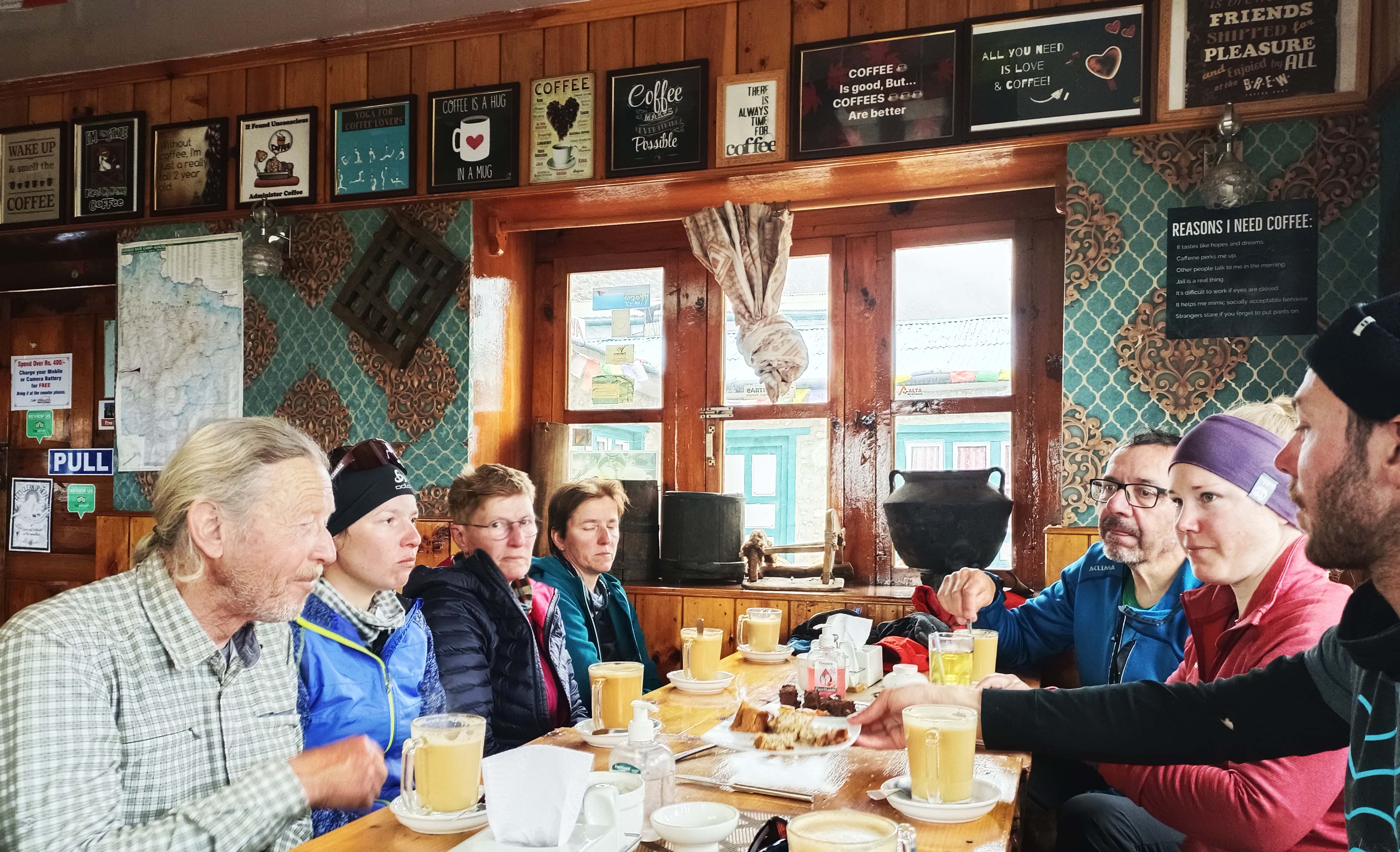 Having Dinner at a Typical teahouse dining room in the Everest Region.
Having Dinner at a Typical teahouse dining room in the Everest Region.
Accommodation on the Everest Three Passes Trek is run mostly by teahouses and lodges in villages and settlement points along the route. Accommodation varies from basic to quite pleasant, with twin-sharing rooms, shared bathroom facilities, and limited heating facilities during winter periods. Food is typically Nepalese local food like dal bhat (rice and lentils), noodles, soups, and some Western foods. Prices increase with altitude due to transportation costs. Some lodges have hot showers and internet access for extra fees. Fluid intake and balanced meals are required for remaining energetic and aiding acclimatization during the trek.
Short Itinerary for the Everest Three Pass Trek
Day 1: Arrival in Kathmandu (1,335 meters)
Day 2: Fly to Lukla (2,840 meters) and hike to Phakding (2,610 meters) ↑1490m ↓ 230m
Day 3: Trek to Namche Bazaar (3,440 meters) ↑925m↓95m
Day 4: Acclimatization Day at Namche Bazaar ↑↓360m
Day 5: Trek to Tengboche (3,860 meters) ↑610m ↓190m
Day 6: Trek to Dingboche (4410 meters) ↑660m ↓110m
Day 7: Trek to Chukung (4,730 meters) ↑520m
Day 8: Acclimatization Day at Chukung
Day 9: Cross Kongma La Pass (5,535 meters) and Trek to Lobuche (4,910 meters) ↑805m↓625m
Day 10: Trek to Gorakshep (5,140 meters) ↑230m
Day 11: Climb Kala Patthar (5,550 meters) and Return to Lobuche (4,910 meters)↑410m↓640m
Day 12: Dzongla Trek (4,830 meters)↓80m
Day 13: Cross Cho La Pass (5,420 meters) and Trek to Dragnag (4,700 meters) ↑590m↓720m
Day 14: Trek to Gokyo (4,790 meters) ↑90m
Day 15: Acclimatization Day at Gokyo
Day 16: Cross Renjo La Pass (5,360 meters) and Trek to Lungdhen (4,368 meters) ↑570m↓992m
Day 17: Trek to Thame (3,820 meters) ↓548m
Day 18: Trek to Monjo (2,835 meters) ↑145m↓1130m
Day 19: Trek to Lukla (2,840 meters) ↑350↓345
Day 20: Fly back to Kathmandu (1,350 meters)
Day 21: Free day in Kathmandu
Day 22: Departure
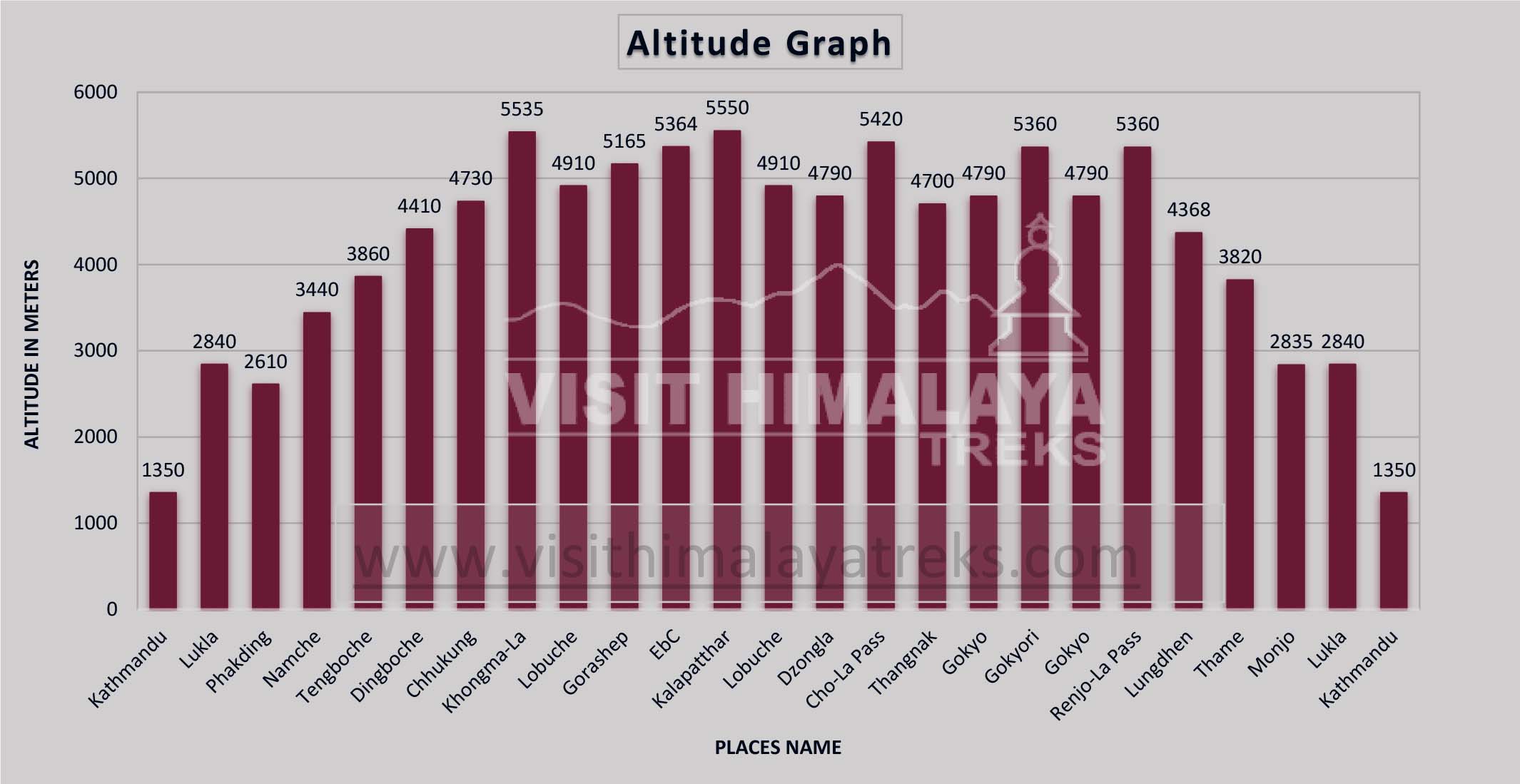
Altitude Graph for the Everest Three High Passes Trek.
FAQs: Everest Three High Passes Trek Package
1. How difficult is the Everest Three High Passes Trek?
The trek is difficult due to long days' walks, high altitude (passes over 5,300m), and tough terrain. It requires a good fitness level and proper acclimatization.
2. What is the best time to do the Everest Three High Passes Trek?
The best seasons for the trek are spring (March to May) and autumn (September to November), which have stable weather, clear skies, and moderate temperatures.
3. What documents are necessary for this trek?
You require a Sagarmatha National Park permit, a Khumbu Pasang Lhamu Rural Municipality permit, and a Nepal entry visa.
4. Is it necessary to hire a guide and porter?
Even though not mandatory, it is recommended to have a guide and porter for safety, local assistance, and to optimize your trekking experience.
5. What kind of accommodation can be seen on the trek?
Accommodation is largely basic to moderate teahouses or shared toilets in lodges. Facilities improve as you descend.
6. What is the quality of food on the trek?
Teahouses offer a choice of foods like local Nepali dishes and Western food. Food is plain but filling.
7. How do I prepare physically for the trek?
Training must be in the form of cardiovascular exercise, building up the muscles, and long treks with a loaded pack several weeks before the trek.
8. What should I pack for the Everest Three High Passes Trek?
Essential equipment includes warm layered clothing, waterproofs, trekking boots, trekking poles, a sleeping bag, sun protection, and a first aid kit.
9. Is altitude sickness common on this trek?
Yes, altitude sickness is likely due to high altitudes. Acclimatization days and hydration help to minimize risks.
10. May I have mobile network and internet connectivity on the trail?
Mobile phone networks are available in some villages; Wi-Fi can be offered in lodges, but slow and costly.
11. How many daily hours do I trek?
Average trekking days are 5 to 8 hours based on altitude, terrain, and pace.
12. Is this trek tailor-made?
Yes, Visit Himalaya Treks has tailor-made itineraries based on your interests, physical condition, and preferences.
Conclusion
Everest Three High Passes Trek is truly an experience of a lifetime, offering unparalleled views of the world's highest peaks, vibrant Sherpa culture, and the excitement of crossing three high mountain passes. Demanding in physical terms and requiring careful planning, the experience is highly rewarding in terms of awe-inspiring views and serene alpine landscapes as much as interacting with the hardy mountain people. Whether you are a seasoned trekker looking for a new challenge or a nature enthusiast looking to venture into the very heart of the Himalayas, this trek offers an experience you will never forget.
Through Visit Himalaya Treks, you have the advantage of expert guidance, well-planned itineraries, and complete support during your stay, so that safety and comfort are assured at all times. From procuring permits to reserving accommodations and arranging logistics, their professional team takes care of all the details so that you can focus on simply enjoying the trek. In case you are ready to have an incredible Himalayan adventure, the Everest Three High Passes Trek offers an incredible blend of adventure, culture, and nature that will be etched in the memory forever.
